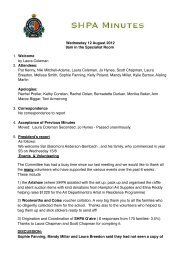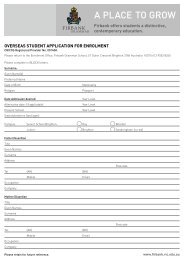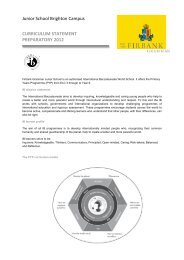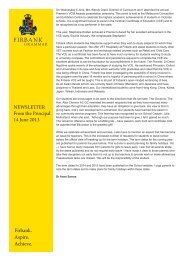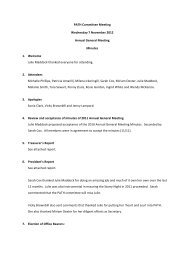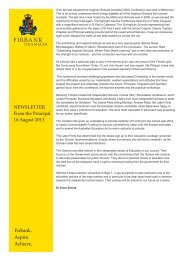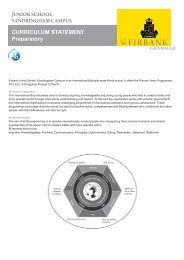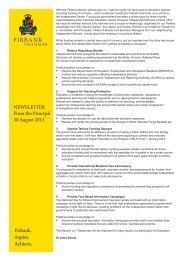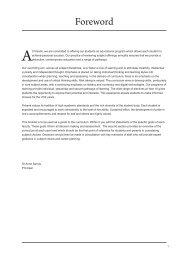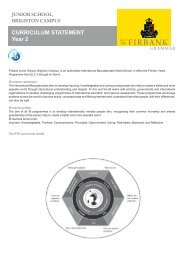CURRICULUM STATEMENT Year 1 - Firbank Grammar School
CURRICULUM STATEMENT Year 1 - Firbank Grammar School
CURRICULUM STATEMENT Year 1 - Firbank Grammar School
You also want an ePaper? Increase the reach of your titles
YUMPU automatically turns print PDFs into web optimized ePapers that Google loves.
Program of Inquiry (POI)As far as possible all subject areas relate to the Programme of Inquiry. Over the course of a year each Grade Level does six Unitsof Inquiry, one from each Transdisciplinary Theme. The <strong>Year</strong> one units are:TransdisciplinaryTheme:Who we are Transdisciplinary Theme: Where we are in place andtimeCentral Idea:Choices we make have animpact on our relationships.Central Idea:Our lives are similar anddifferent to those of othergenerationsLines of inquiry: • Our relationships• How positive choices cannurture relationships.• Rights and responsibilitiesin communitiesLines of inquiry: • Generations• Why and how thingschange over time• How we know about thepast, present and futureConcepts Causation, Responsibility Concepts Reflection, ChangeTransdisciplinaryTheme:Central Idea:Organising ourselves Transdisciplinary Theme: How the world worksPeople choose differenttransportation systems to getfrom one place to another.Central Idea:We use our sensesto interact with ourenvironment.Lines of inquiry: • Kinds of transport peopleuse.• Different transportsystemsLines of inquiry: • Our senses and how weuse them.• Why our senses areimportant.• What do with no orlimited use of sense.• Technology designed toenhance the senses.Concepts Function, Connection Concepts Function, CausationTransdisciplinaryTheme:Central Idea:Sharing the planet Transdisciplinary Theme: How we express ourselvesAn ecosystem is a constantlychanging community of livingthings interacting with oneanother.Central Idea:Cultural beliefs and valuesare reflected thoughtraditions.Lines of inquiry: • The similarities anddifferences between livingand non living things.• Characteristics of ourlocal ecosystems.• Connections withinecosystems.Lines of inquiry: • How artefactssymbolise beliefs andvalues.• How the traditionsreflect beliefs.Concepts Change, Connection Concepts Perspective
LanguageWritingIn <strong>Year</strong> One students will focus on working with a variety of text types including recounts, narratives, procedures, expositions andexplanations. The students will be exposed to and explicitly taught the features of these texts through modelled and shared writingexperiences. They will attempt to incorporate these features into their own writing. The students will be encouraged to use a variety ofadjectives within their writing and to extend their writing by providing the reader with relevant and interesting details. Students will rereadtheir own writing pieces and start to edit their own work by underlining words that don’t ‘look right’ and correcting some incorrectspelling attempts through use of environmental print and personal dictionaries. The students will continue to increase their knowledgeof common spelling patterns and frequently used words. Students will aim at consistently forming lower and upper case letters correctlyand use them appropriately.ReadingStudents in <strong>Year</strong> One will engage in frequent individual, shared and guided reading tasks. The students will work towards extendingtheir range of decoding and meaning making skills by working on strategies such as reading on and going back, observing spellingpatterns within words, looking at the starting letters and ending letters of a word and asking questions such as ‘Does what I have readmake sense?’. Expression and intonation will be a focus for <strong>Year</strong> One students as the students work on their fluency during the readingof familiar texts. Students will be encouraged to experiment with an assortment of texts, from information texts, chapter books, picturestory books, newspapers, magazines and digital texts. Students will give overview of the events and plot of non-fiction books and findspecific information within different text varieties. Students will discuss guided reading texts in small facilitated discussions with an aimat providing students the opportunity to gain a deeper understanding of a text’s meaning.Speaking and listeningIn <strong>Year</strong> One students focus on speaking clearly and audibly at all times, whether presenting in front of the class, conversing withpeers, or contributing to a group discussion. Regular ‘Discovery time’ presentations provide a platform for students to gain practice inpresenting information in a logical sequence and asking appropriate questions. Students will work towards understanding the meaningof listening attentively and responding appropriately. They will also concentrate on improving their listening skills in order to assist themto follow instructions.MathematicsNumberStudents in <strong>Year</strong> One will focus on numbers 0 -100. They count on from 2 and 3 digit numbers, use number lines to locate a numbersposition and begin to recognise patterns that pertain to skip counting. The students use bundling strategies to demonstrate anunderstanding of place value and become familiar with mathematics terms such as greater than, less than, estimate, differencebetween, count up to and count down to. Throughout the year the students work with a variety of addition and subtraction strategies.For example, make to ten [12 + 9 = 12 +10 – 1], doubles, near doubles, fact families and tens facts. Students also add and subtract2 digit numbers using a hundreds chart. In <strong>Year</strong> One students are introduced to partition (sharing) and quotation (how many) divisionsituations and learn to form arrays to demonstrated multiplication situations (often referred in year one as lots of or groups of; forexample 4 groups of 3).Measurement, Chance and DataStudents learn to read and use calendars, describe familiar time patterns and use informal and formal units to measure analogueand digital time. Students explore the measurement of length, width and capacity using non-uniform (eg. Hand spans) and uniform(Popsicle sticks) units. Students use simple graphical displays to organise categorical data. Everyday language such as unlikely anddefinitely are used when considering the nature of chance events.SpaceKey features of shapes and solids are identified by students in <strong>Year</strong> One. Students describe and draw regular two-dimensional shapesand attempt to construct simple three-dimensional shapes. Students understand the meaning of symmetry and use mirrors and foldingto explore the symmetry of different objects. The location of objects using simple directions, and informal maps is investigated.Working mathematicallyStudents are supported to use familiar mathematical or everyday language and concrete aids (such as pictures and blocks) to expresstheir thinking in mathematics. They recognise that there are numerous terms to describe the same idea (eg. ‘join’, ‘plus’, ‘and’ all meanadd) . The students use their previous knowledge and strategies that are purposefully modelled and taught to solve posed problems.They are asked to explain their answers and encouraged to generate reasoned answers.
ArtA PYP visual arts classroom will further develop a student’s understanding of the central idea of many units of inquiry by linking thecreative disciplines of visual arts to other disciplines. Sometimes the visual arts program will build on its own lines of inquiry. Studentsin <strong>Year</strong> One will use a variety of starting points for artwork including their immediate environment and their own experiences to expresstheir thoughts, feelings and personal stories. They will be introduced to several art forms including printmaking (mono-prints), textiles(weaving/tapestry), drawing, painting, sculptures using paper and puppet making. Students will begin to formulate understandingsabout the elements of colour, line, shape, space, form and texture through the exploration of a variety of art materials and tools. Theywill work both independently and in pairings to explore and trial these art materials and tools. They will be exposed to artforms associated with personal and cultural events that are recognized through celebrations and traditions. They will begin to makeshort statements about their work and the work of others. Students will use Visual Diaries to make planning sketches for artwork and toexplore and trial art materials.Mandarin<strong>Firbank</strong> is introducing Mandarin (Chinese) as an additional language from 2011. All learners benefit from having access to differentlanguage and as a consequence, access to different cultures and perspectives. Communication skills in a language other thanEnglish foster intercultural knowledge and awareness of language as a system. Students will develop skills of listening, speaking,reading, viewing, writing and the use of body language , visual cues and signs. The intercultural knowledge and language awarenessdimension develops students’ knowledge of the connections between language and culture, and how culture is embedded throughoutthe communication system. The understandings are universal and are gained by comparing languages, including English.LibraryStudents will visit the Jill Forster Resource Library for a weekly lesson. During library time they are exposed to a variety of textsencouraging a love of reading. Students are given the opportunity to change books weekly.MusicIn <strong>Year</strong> 1 students continue develop an understanding of the main elements of music; beat (or no beat), pitch (me; fa; so; la and high/low), tempo (fast/slow), dynamics (loud/soft), tone colour (jazz and rock instruments), texture (thick/thin) form (different sections andphrases) and style (music from different lands, times and for different purposes). Singing lies in the heart of the curriculum wherestudents display confidence and expression. Students play musical pieces using a range of instruments. They perform solo and aspart of an ensemble for a variety of audiences. Students use their imagination and musical experience to organise sounds into variousforms that communicate specific ideas and moods. Students use non-traditional and traditional notation to record their compositions.Students are given the opportunity to hear then identify and describe various musical elements. They distinguish the different tonecolour of instruments and respond to a wide and varied repertoire of musical styles as well as to music from different times andcultures.Physical EducationPhysical Education within <strong>Year</strong> 1 offers the children the opportunity to demonstrate basic motor skills and some more complex skills.They combine motor skills and movement patterns during individual and group activities. They demonstrate control when participatingin locomotor activities requiring change of speed, direction and level. They create and perform simple rhythmical movement sequencesin response to stimuli. They regularly engage in sessions of moderate to vigorous physical activity and describe the link betweenphysical activity and health. They explain the contribution rules and procedures make to safe conduct of games and activities. They useequipment and space safely. Students have begun to learn about movement by playing games that promote self-control when running,leaping, jumping and dodging. They also begin learning skills in a variety of games and activities, with hand/eye coordination andworking in pairs and small groups as their main focuses.ICT – Information Communication TechnologyStudents use the networked computers in the classroom as well as in the Jill Forster Resource Library. They continue to develop skillson Kidspiration and “2 Create-a-story”. Kidpix is used to present information and demonstrate understandings. Students are shownbasic word processing skills and are provided with opportunities to use these skills in context. Students visit the library during the weekfor ICT skills based lessons. They are introduced to basic robotics using Beebots. They learn how to create, test, modify and storeinstructions to control the movements of the Beebot. They also learn to program the Beebot by using single instructions, a sequenceof instructions and repeated sequences. Students discover that information exists in a variety of forms, including text, still and movingpictures, charts and sounds and that different media are used for different purposes. They continue to express themselves usingdigital stories with “2 Create-a-story” and begin to also use “Pivot stick animation” to take action and share their learning experiences.“Super Duper Music Looper” is introduced for music creation and this is incorporated into the development of media. Students developresearch skills using ICT and learn to confidently navigate software interfaces.



